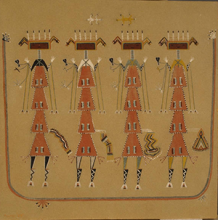Article
Also known as sandpaintings or dry paintings, sand paintings (or iikááh in Navajo) are created by a medicine man (or Hataałii in Navajo) for ceremonial purposes. Sand paintings are created by pouring colored sands, crushed dried plants, crushed stone, or other powdered pigments onto the ground. Sand paintings are generally symbolic representations of different stories in Navajo mythology and are created in conjunction with the performance of certain chants. Navajo sand paintings began as an integral part of religious and healing ceremonies rather than as art for art’s sake. However, many Navajo artists currently produce sand paintings for the commercial art market. Sand paintings created as art generally contain important errors so that it is not an exact replica of a sacred ceremonial sand painting.
"Second Day, Mountain Chant, circa 1965," sand painting, (1990.01.1773). Hubbard Museum of the American West, Ruidoso Downs, NM. All rights reserved. Use with permission only.
Manuscripts
A05 Listening Woman (02-13) p. 17
A05 Listening Woman (02-13) p. 18
A05 Listening Woman (02-13) p. 19
A05 Listening Woman (02-13) p. 62
A05 Listening Woman (02-13) p. 63
A05 Listening Woman (02-13) p. 64
A05 Listening Woman (02-13) p. 73
A05 Listening Woman (02-13) p. 74
A05 Listening Woman (02-13) p. 75
A05 Listening Woman (02-13) p. 130
A05 Listening Woman (02-13) p. 131
A05 Listening Woman (02-13) p. 133
A05 Listening Woman (02-13) p. 157
A05 Listening Woman (02-13) p. 173
A05 Listening Woman (02-13) p. 228
A05 Listening Woman (02-13) p. 247
References
Frisbie, Charlotte J.
1987 Navajo Medicine Bundles or Jish: Acquisition, Transmission, and Disposition in the
Past and Present. Albuquerque: University of New Mexico Press.
Hirschfelder, Arlene and Paulette Molin
2000 Encyclopedia of Native American Religions. New York: Checkmark Books.
Wyman, Leland
1960 Navaho Sandpainting: The Huckell Collection. Colorado Springs: The Taylor
Museum.

